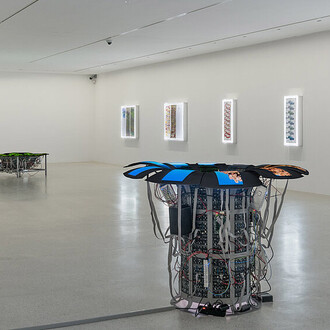For visual artists the book has always been an object of fascination. Whether as a receptacle that encloses the content, as an object beyond word and meaning, as a hermetic medium that can be deconstructed with artistic means, or as a background for images, that can be covered with ornamental letters and figurations. The allegedly fundamental contradiction between image and text - the one, an aesthetic configuration that can be apprehended and deciphered at a glance, the other, a narrative structure that must be sequentially decoded in order to demonstrate its qualities - is at the same time a driving force in the reciprocal fertilisation of the two artistic means of expression. Under the influence of the book / of book culture, art can develop a narrative dimension, and the set of texts, under the spell of pictorial representative forms, can develop an aesthetic dimension that perhaps tells a completely different story than the letters that might be hidden / concealed in it.
"Books and Papers II" continues an exhibition from the year 2015, and, with a different list of artists, reveals new facets in the relationship between text and image, or, if one wishes to express it in structuralist terms, between signifier and signified: the spectrum reaches from works in the tradition of concrete poetry up to works in the style of illumination, which radiate the magic of the archaic. Then there are artefacts which, using graphic means, address the role of photography as an instrument of documentation, and classic oil-on-canvas painting, which captures the burden and the pleasure of bibliophily.
Books and Papers: in this field of tension, a dialectic of the apprehension of the world and, at the same time, the forlornness of the world is played out: the aesthetic appropriation of the meaningful artefact plays on diverse keyboards, which engender a visual polyphony with occasional dissonances. "Books and Papers II" combines irony and rigorous conceptualism, classical transcendence and anacreontic play, sublime exaltation and then in turn grotesque disintegration of form. In the thoroughly adversarial interaction and also in the aesthetic contradiction, in the actuation of different cerebral areas, and in the meaningless marvelling and quivering, without comprehension, the potentialities of existential teleologies unfold, aiming at the absolute, and in missing the mark surveying the frontiers of the human. "Reading means dreaming by means of foreign hands", the Portuguese author Fernando Pessoa once wrote. One could also invert the phrasing: to dream in the contemplation of art, means reading by means of foreign hands.
















